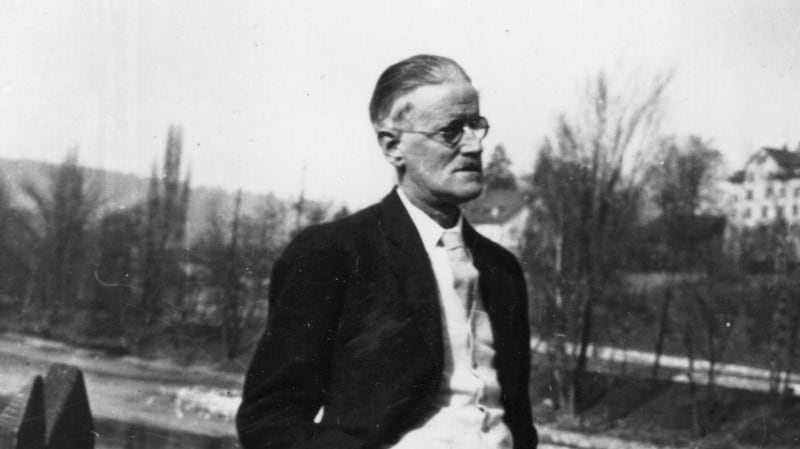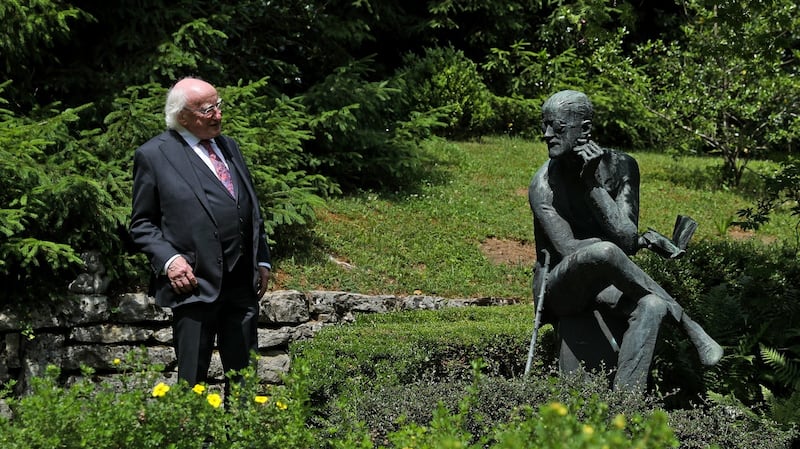The somewhat macabre suggestion that James Joyce’s remains might be brought to Ireland is not a new one. It has come up every now and again since his death in Zurich in 1941. Brian O’Nolan writing as Flann O’Brien suggested ‘reinterring him at his own beloved Dublin’ in the letters page of this newspaper back in 1962, noting that ‘a great many people would be happy to contribute to the cost of the new funeral’.
It should be remembered that Joyce and Nora Barnacle definitively left Ireland in 1904 aged 22 and 20 respectively. Joyce spent his whole adult life as what he himself termed “a voluntary exile” in Europe (Pula, Trieste, Zurich, Trieste, Paris, Zurich) with interludes in London in the latter years. He carried a British passport and never felt inclined to get an Irish one . Joyce felt the Ireland of his time did not give him the space to think or write and he needed to get away so as to write about his country from ‘the safe side of distance’ as he puts it in Finnegans Wake.

Joyce’s writings are inextricably Irish, unceasingly focused on Dublin. They celebrate but also unswervingly dissect the society that he left behind, taking aim at the Catholic Church, the British Colonial machine (“Where Christ and Caesar are hand in glove” as Joyce’s polemic “Gas from a Burner” puts it), but equally dismantle reactionary Irish nationalism. As his Irish Times obituary put it: “James Joyce was an Irishman of the Irish. He also might be described as the complete Dubliner. Although he had not set foot on Irish soil for more than twenty years, he hardly ever wrote a line that was not steeped in the atmosphere of his native city”.
Works condemned
Although he always had a coterie of Irish readers and critical supporters in the early decades, his works were condemned or simply ignored at home. In a country beset by draconian censorship, Ulysses and Finnegans Wake were considered so far beyond the reach of the general public that they did not need to be banned. As the Catholic Irish Monthly put it in 1924, Joyce’s books were “afflicted with a shameful mania” but they were “but little read by sane folk”.
Dubliners today will probably be more concerned with finding homes for the growing numbers of homeless in the city than they are with finding a new home for the deceased
When Joyce died in Zurich in January 1941, having made enquiries about whether or not he died a Catholic (he didn’t), De Valera’s government pointedly refused to send any diplomatic representatives to his funeral. Later when Nora expressed a willingness to allow the repatriation of his remains, the offer was turned down by then then Minister for External Affairs, Seán MacBride.
Nora was so upset by this refusal that she intervened with Joyce’s great sponsor and supporter Harriet Shaw Weaver to ensure that she donate the manuscripts of Finnegans Wake not to the National Library in Dublin, but to the British Museum.

Nowhere did Joyce ever express any desire to be buried in Dublin. While this current proposal signals an Ireland which is more open and more open to Joyce, it is hard not to see the request to repatriate his bones as an ill-conceived plan driven by political opportunism or the hope of gain in the field of cultural tourism. It happens in a larger context in which significant pieces of Joyce’s Dublin remain under threat. The house of Leopold and Molly Bloom on 7 Eccles Street was torn town in the late 60s, the Ormond hotel, site of the Sirens episode in Ulysses recently suffered a similar fate, while national and civic officialdom has refused to buy or secure the house in which his great short story “The Dead” took place: another great Joyce site risks ruin.
Usher’s Island
Councillors Dermot Lacey (Labour) and Paddy McCartan (Fine Gael), who are proposing to bring Joyce’s body home might better use their energies to see about finding a way to preserve Usher’s Island, the “House of the Dead”, as a vital location on any heritage map of Dublin and one to list alongside the gems that are the National Library of Ireland (with its wonderful hoard of expensively acquired Joyce materials), and the recently opened MoLI (The Museum of Literature Ireland) in Newman House.

There is no evidence of great public groundswell in favour of repatriation. Joyce remains part of the atmosphere of what is a very different Dublin and is feted every Bloomsday by an ever increasing group of people in Ireland and beyond. 2022, the centenary of the publication of Ulysses, will undoubtedly offer wall-to-wall Joyce. However Dubliners today will probably be more concerned with finding homes for the growing numbers of homeless in the city than they are with finding a new home for the deceased even if those deceased are James and Nora Joyce.
When he was asked whether he might ever return to Ireland, Joyce's answer came in the form of a question: 'Have I ever left it?'
Joyce is currently buried comfortably in the beautiful Friedhof Fluntern in Zurich along with Nora, his son, Giorgio, and Giorgio’s second wife, Asta Osterwalder Joyce. Should these bodies be separated in death? I think not and I doubt that Joyce’s only grandson, Stephen, would sanction such an action. When he was asked whether he might ever return to Ireland, Joyce’s answer came in the form of a question: “Have I ever left it?”
In many ways he never did leave and in any case, Dublin will always belong to Joyce. It is fitting that Zurich, the last European city to give Joyce and his family refuge, should be the one where he lies in rest, eternally.
John McCourt is Professor of English literature at the Università di Macerata







